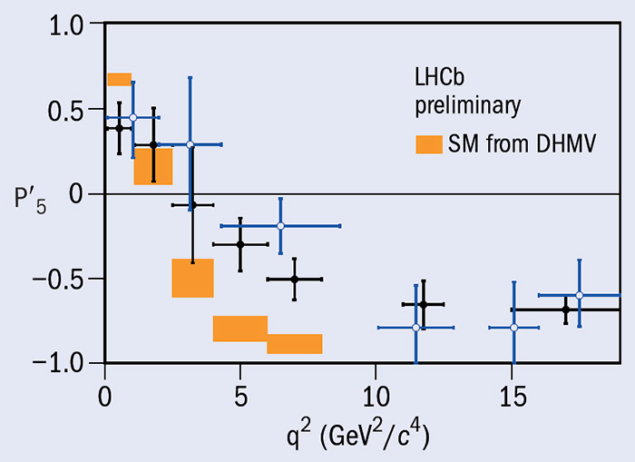
At the recent Moriond Electroweak (EW) conference at La Thuile, the LHCb collaboration presented an updated angular analysis of the decay B → K*0 μ+μ– using the experiment’s full data set from the LHC’s Run 1 (LHCb Collaboration 2015). This is an update of an earlier measurement based on the 2011 data alone, which showed a significant discrepancy in one angular observable (referred to as P´5) compared with predictions from the Standard Model. Because the discrepancy could be interpreted as a sign of physics beyond the Standard Model, it provoked considerable discussion within the particle-physics community, and the update with the full Run 1 sample has been eagerly awaited.
The decay of a B meson (containing a b quark and a d quark) into a K*0 meson (s and d) and a pair of muons is quite a rare process, occurring around once for every million B meson decays. At quark level, the decay involves a change of the quark flavour, b → s, without any change in charge. Such flavour-changing neutral processes are forbidden at the lowest perturbative order in the Standard Model, and come from higher-order loop processes involving virtual W bosons. In many extensions of the Standard Model, new particles can also contribute to the decay, leading to an enhancement or (through interference) a suppression in the rate of the decay. The contributions from new particles beyond the Standard Model can also change the angular distributions of the kaon and pion from the K*0 decay, and of the muons.
The analysis shown at Moriond, which is the first by any experiment to explore the full angular distribution of the decay, confirms the discrepancy seen in the 2011 data. At low dimuon masses, there is poor agreement between the current Standard Model predictions and the data for the P´5 observable. The two measurements in the range 4 < q2 < 8 GeV2/c4 are both 2.9σ from the Standard Model calculation (see figure).
Two invited theory talks followed LHCb’s presentation at Moriond. Both speakers were able to give an initial interpretation of the results, and found a consistent picture (see, for example, Straub and Altmannshofer 2015). A model-independent analysis favours a best-fit point that is about 4σ from the current Standard Model predictions.
It is, however, still too soon to claim evidence of new particles. The major challenge in interpreting the results lies in separating the interesting physics from poorly known QCD effects, which could be larger than first expected and hence responsible for the discrepancy. No matter the cause of the anomaly, there will need to be some rethinking of the current understanding of the B → K*0 μ+μ– decay.





